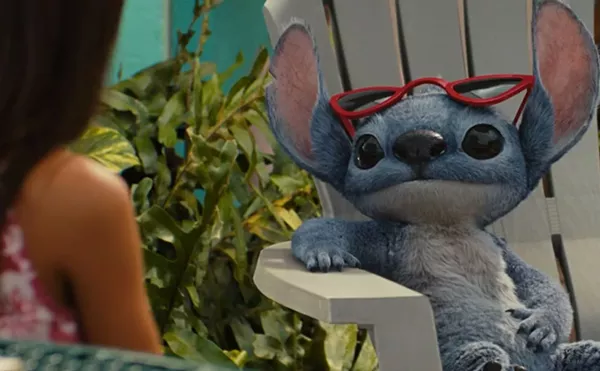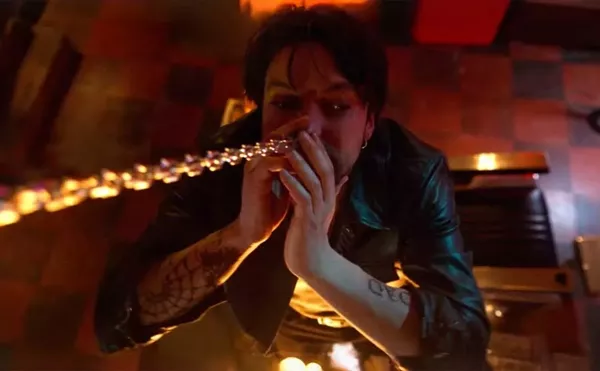
Audio By Carbonatix
[
{
"name": "GPT - Leaderboard - Inline - Content",
"component": "35519556",
"insertPoint": "5th",
"startingPoint": "3",
"requiredCountToDisplay": "3",
"maxInsertions": 100,
"adList": [
{
"adPreset": "LeaderboardInline"
}
]
}
]
Since this is a Hong Kong horror film, one can expect it to be very stylish, which it is — and fairly irrational, which it is as well, though a certain triumph of the irrational is essential to the genre.
Horror films are intrinsically conservative, not in any political sense, but culturally, in the way they posit the persistent power of the supernatural in a modern world of reason and science. Reason has lifted mankind above our station and given us a false sense that night’s black agents have been banished — but in the traditional horror film, such doubters and naysayers are laid to waste by inhuman claws and gropers from the grave. Even in the original The Thing (a sci-fi film and so, one would think, on the side of progress), the human villain is a scientist who thinks he can reason with a monster from outer space, and his faith in his intellectual abilities makes him a puny fool and dangerous to boot.
Then there’s the “He tampered in God’s domain” (cf. Ed Wood’s immortal Bride of the Monster) aspect of the horror/sci-fi film (in movies, the two genres mingle much more freely than in literature) represented in The Eye by a cornea-transplant operation meant to restore the sight of a young, blind violinist. Transplant horror has its own tradition, from Karl Freund’s Mad Love (1935) with Peter Lorre (the most famous of several adaptations and variations of Maurice Reynard’s novel, The Hands of Orlac), through several head- and brain-transplant movies, and at least one very good face-transplant movie (Georges Franju’s Eyes Without a Face). If everyday reality is a thin scrim hiding the awaiting terrors of the night, then it’s obvious that people who have the hubris to commit unconventional transplants (hearts and livers don’t count) are just asking for trouble.
The Eye is directed by twin brothers, Oxide Pang Chun and Danny Pang — the young violinist is a girl named Min (Lee Sin-Je). The cornea transplant seems successful, though soon Min, still in the hospital, seems to be seeing a strange personage leading certain patients away in the dead of night. It soon becomes clear that, yes, she sees dead people and eventually, as a kind of evil bonus, also seems to be able to foresee disastrous events. This is presented in the context of Min trying to adjust to her new ability to see (a disorientating experience even without the ghostly apparitions) and her relationship with her sister, too self-absorbed to really notice Min’s distress, and her growing attachment to the young shrink who will eventually help her solve the mystery of her visions.
In the first part of the movie, we see these visions as Min sees them, which is indistinctly and out-of-focus. This is one of the movie’s cleverest conceits: Blurriness is a good substitute for the subjective camera often used to hide the source of evil, that approach having been done to death by countless low-budget horror films (since shooting from the murder-monster-madman-whatever’s point of view is a fast and cheap alternative to devising shots that hide the perpetrator’s identity). By putting us in the killer’s position, the filmmaker is asking us to indulge our alleged desire to commit a brutal murder, especially when the victim is a helpless woman — or such has been the dubious assertion of many critics whose feminist sensibilities are keener than their knowledge of B-movie priorities, which are, first and last, matters of saving money. Anyway, the brothers Pang have a masking device that grows organically from their story and they use it well.
Along with smudgy visuals, the first part of the movie goes heavy on the shock cuts and sudden loud noises, effective interruptions in a narrative that leans toward the quiet and introspective. The last part of the movie — the solving of the mystery, the upping of the supernatural-mumbo jumbo ante and a climactic scene oddly reminiscent of The Mothman Prophecies — doesn’t really live up to the promise of its beginning. But then supernatural solutions are rarely as satisfying as supernatural mysteries.
The idea that there’s much more going on in the world than meets the eye is totally plausible, while the unveiling of the underlying evil can seem like, well, something you might see in a movie.
Opens Friday exclusively at the Main Art Theatre (118 N. Main, Royal Oak). Call 248-263-2111.
Richard C. Walls writes about film for Metro Times. E-mail letters@metrotimes.com.





